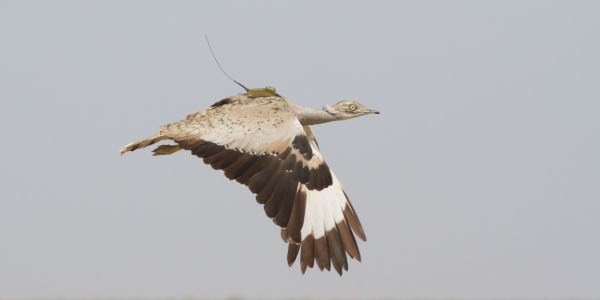LINKED PAPER
Backpack harness solar powered PTTs do not affect reproductive traits in Asian Houbara Chlamydotis macqueenii. Burnside, R.J., Guilherme, J.L., Collar, N.J. & Dolman, P.M. 2019. European Journal of Wildlife Research. DOI: 10.1007/s10344-019-1332-0. VIEW
Arguably nothing has given a greater insight into the secret world of animals than the advent of biologging devices. From showing the 71,000 km round trip migration of the Artic Tern (Sterna paradisaea), to the 3,100 km ocean crossing of the Amur Falcon (Falco amurensis), not to mention the insights into energy budgets, flight dynamics, breeding productivity, survival rates and population processes. However, these devices must be attached to the animal, and despite the important information they can yield, they can have negative effects on the individual carrying them.
In the past, transmitters were extremely expensive which often meant just a few individuals could be tracked. However, the development of affordable biologging technology based on GSM transmissions and 3D printing is leading to increasing use of biologging devices on more species and deployments on larger numbers of individuals within a study. This has the potential for widespread negative effects if biologging methods are not sufficiently trialed beforehand. This is worrying for animal welfare, particularly for threatened species, and puts doubt on the reliability of derived parameters. There is an ever more pressing need for due-diligence prior to deployment of devices and to assess if there are any negative effect after deployment.
Our work on the sustainable management of the Asian Houbara (Chlamydotis macqueenii) has relied heavily on the use of Argos-based GPS tracking devices (30g + 45g PTT-100 from Microwave Telemetry, Fig. 1) attached using back-pack harnesses made of 6.5mm wide Teflon ribbon. The Asian Houbara is highly cryptic, living in remote deserts and migrating between nearly inaccessible countries (Turkmenistan, Afghanistan, Pakistan, Iran, Iraq) limiting the possibility to follow them with anything but satellite PTTs. Research programmes have tracked Houbara using PTTs since the late 90s. All available observational evidence suggested the Houbara were not negatively affected, but this had never been formally tested.

Figure 1 Female Asian Houbara flying with a back-pack mounted PTT © R.J. Burnside
The recent meta-analysis by Bodey et al. (2018), which examined the effects of transmitters in relation to a variety of life history traits and also device attachment methods and weight, found long-distance migrants that use flapping flight tracked with transmitters >1% of body weight and fitted with a back-pack harness were likely to be prone to negative effects of carrying biologging devices. These are the exact conditions of the Asian Houbara. Therefore, while I was sure there were no profound detrimental effects, I decided to investigate if there were any subtle negative effects of back-pack transmitters on the breeding performance of Asian Houbara.
Video 1 Sample of Asian Houbara nesting in the KyzylKum Desert
Using our dataset of Asian Houbara breeding productivity gathered during fieldwork in the Bukhara province of Uzbekistan between 2012 and 2018 (Video 1), we compared six breeding parameters from 114 nests of 38 females carrying PTTs to 184 nests of untagged birds. Many PTT females were monitored over multiple years and Video 2 gives an example of the annual cycle of two females tracked over four years, returning each breeding season to Bukhara. Controlling for other factors known to influence breeding performance, we found no difference between the PTT and untagged groups for any the examined parameters: lay date, clutch size, mean egg weight, nest success, egg hatchability or chick survival to fledging (Fig. 2). This was clearly good news and reassuring that our estimates were unaffected by the transmitters.
Video 2 Annual movements of two female Asian Houbara tagged in Bukhara, Uzbekistan in 2014 and followed for four years
 Figure 2 Estimates of breeding parameters for birds with and without PTT transmitters. The left hand column shows real data and model estimates. The right hand column shows the result of multimodel inference, any covariate that passes the dashed line has a significant effect while those below have no effect on breeding parameter. Click to view larger
Figure 2 Estimates of breeding parameters for birds with and without PTT transmitters. The left hand column shows real data and model estimates. The right hand column shows the result of multimodel inference, any covariate that passes the dashed line has a significant effect while those below have no effect on breeding parameter. Click to view larger
A key component of our tagging programme is the collaboration with the Emirates Bird Breeding Centre for Conservation, a houbara breeding centre, which allows us to undertake extensive training in fitting transmitters to captive-bred birds. We can monitor individuals in captivity and examine them over time to ensure the there are no obvious negative effects.

Ultimately, any scientist should consider on a case by case basis the tagging system used to monitor an animal, researching how similar animals have responded, and practice the attachment procedure sufficiently before deploying these techniques on a wild animal. Tagging should then begin on a small trial basis to rule out any obvious negative effects before making larger scale deployments with continued monitoring to ensure the best welfare standards are met. Importantly, for the work on the Asian Houbara, we can have confidence that the estimates of breeding productivity derived from transmitters are reliable.
References
Bodey, T.W., Cleasby, I.R., Bell, F., Parr, N., Schultz, A., Votier, S.C. & Bearhop, S. 2018. A phylogenetically controlled meta-analysis of biologging device effects on birds: deleterious effects and a call for more standardized reporting of study data. Methods Ecol Evol 9:946–955. VIEW
Image credit
Featured image: Female Asian Houbara Chlamydotis macqueenii flying with a back-pack mounted PTT © R.J. Burnside




